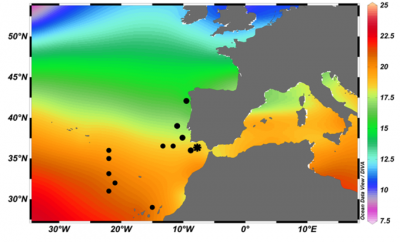Page path:
- AG Kucera
- Research
- Paleoceanography
- Planktonic foraminifera as indicators for eastern Atlantic hydrography
Planktonic foraminifera as indicators for eastern Atlantic hydrography
Shells of planktonic foraminifera serve as an archive of the chemical and physical conditions under which they have been constructed. Thus, their actual presence in all marine environments and ultimately in marine sediments, make these organisms important recorders of past ocean conditions. To make the most of the potential of planktonic foraminifera when doing reconstructions, the modern environmental and habitat preferences of species need to be constrained.
This project aims to:
- contribute to a better understanding of modern planktonic foraminifera ecology;
- improve the understanding in species-specific incorporation of seawater stable isotopes values into carbonate shells;
- apply this new knowledge to past conditions, namely the Last interglacial (MIS5e).
The study area lies between the Azores Islands and western Iberian Margin, a region influenced by the Azores Current, the Mediterranean Outflow Water and by seasonal upwelling.

Fig. 1 – Location of plankton tows and water samples collected during various research cruises (black dots), to constrain the habitat and stable isotope geochemistry of planktonic foraminifera. Location of the marine sediment core from IODP Site U1390 (black asterisk) to the paleoceanographic purpose of the project. Underneath, the annual SST (Sea Surface Temperature) mean for the year 2009.


